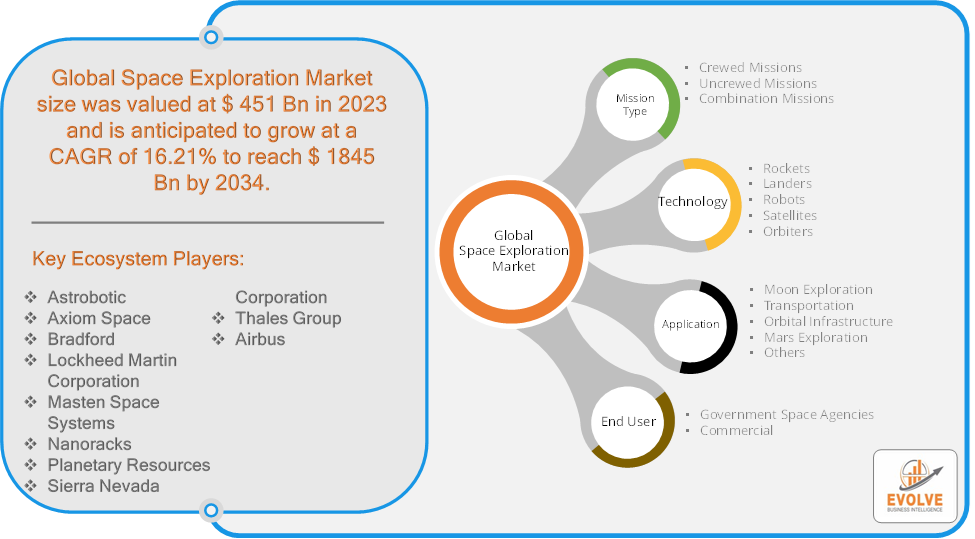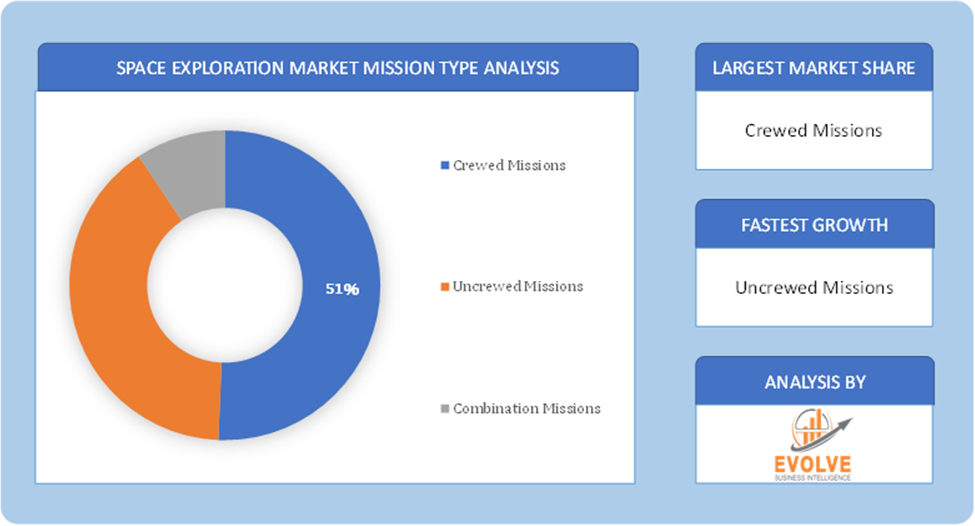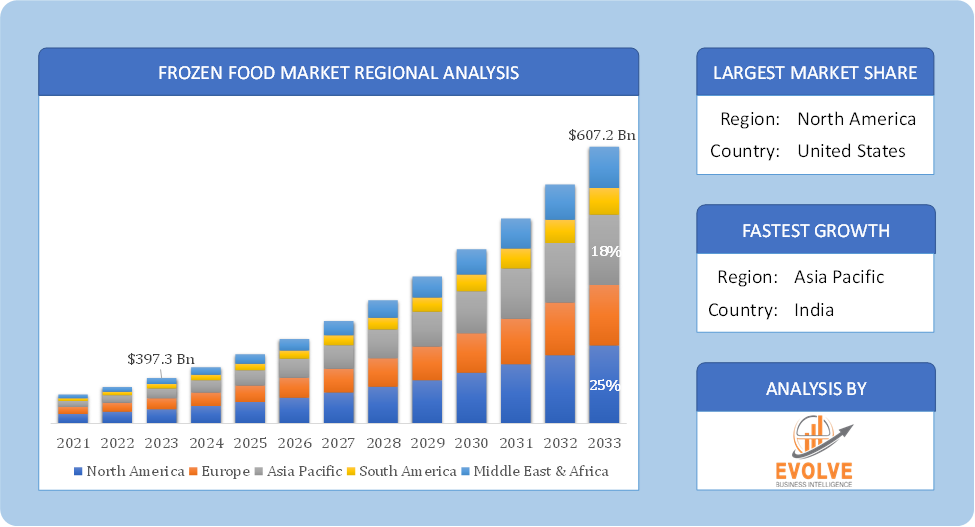Space Exploration Market Overview
The Space Exploration Market Size is expected to reach USD 1845 Billion by 2033. The Space Exploration Market industry size accounted for USD 451 Billion in 2023 and is expected to expand at a compound annual growth rate (CAGR) of 16.21% from 2023 to 2033. The space exploration market encompasses the commercial activities, research, and development related to exploring outer space. This market includes a wide range of activities, from satellite launches and space tourism to the development of advanced technologies for space exploration.
The Space Exploration Market is driven by both government and private sector investments, technological advancements, and the increasing interest in commercializing space-related activities. The market is expected to grow significantly as new technologies emerge and the cost of access to space decreases.
Global Space Exploration Market Synopsis
 Space Exploration Market Dynamics
Space Exploration Market Dynamics
The major factors that have impacted the growth of Space Exploration Market are as follows:
Drivers:
Ø Technological Advancements
Innovations in space technology, including reusable launch vehicles, advanced propulsion systems, and miniaturization of satellites (such as CubeSats), are driving market growth. These advancements are making space exploration more efficient and cost-effective. The need for accurate and real-time data on climate change, natural disasters, and environmental monitoring is driving the deployment of satellites and other space-based technologies. Space exploration contributes to the development and operation of these systems.
Restraint:
- Perception of High Costs and Technical Challenges
Space exploration is inherently expensive, requiring significant investment in research, development, manufacturing, and launching. The high cost of missions, spacecraft, and infrastructure can limit the participation of both governments and private companies, particularly in less economically developed regions. Space exploration involves complex and risky operations, including launching spacecraft, sustaining life in space, and navigating distant celestial bodies. Technical failures, such as launch mishaps, equipment malfunctions, or mission failures, can result in substantial financial losses and setbacks.
Opportunity:
⮚ Space Mining and Resource Utilization
The potential for extracting valuable resources from asteroids, the Moon, and other celestial bodies presents a long-term opportunity. Companies and governments could explore space mining to obtain minerals, water, and other resources that could support both space missions and Earth’s needs. Innovations in propulsion technologies, such as nuclear propulsion, ion thrusters, and reusable launch vehicles, offer opportunities to reduce costs and improve the efficiency of space missions. Companies investing in next-generation propulsion systems could gain a competitive edge.
Space Exploration Market Segment Overview
Based on Mission Type, the market is segmented based on Crewed Missions, Uncrewed Missions and Combination Missions. The Uncrewed Missions segment dominant the market. Uncrewed missions are critical for exploring planets, moons, and other celestial bodies to gather data on their geology, atmosphere, and potential for life. These missions provide essential data to support future human exploration, such as identifying landing sites on Mars or the Moon and studying the effects of space environments.
By Technology
Based on Technology, the market segment has been divided into Rockets, Landers, Robots, Satellites and Orbiters. The Robots segment dominant the market. Robots that operate in orbit around Earth or other celestial bodies. They may conduct satellite maintenance, space debris removal, or provide imaging and communications support.
By Application
Based on Application, the market segment has been divided into Moon Exploration, Transportation, Orbital Infrastructure, Mars Exploration and Others. The Moon Exploration segment dominant the market. The growing number of worldwide space exploration efforts and operations has bolstered the moon exploration mission significantly.
By End User
Based on End User, the market segment has been divided into Government Space Agencies and Commercial. The Commercial segment dominant the market. Private companies are increasingly responsible for the deployment and operation of satellites for communication, earth observation, weather forecasting, and navigation. These services are critical for various industries, including telecommunications, agriculture, and defense.
Global Space Exploration Market Regional Analysis
Based on region, the global Space Exploration Market has been divided into North America, Europe, Asia-Pacific, the Middle East & Africa, and Latin America. North America is projected to dominate the use of the Space Exploration Market followed by the Asia-Pacific and Europe regions.
 Space Exploration North America Market
Space Exploration North America Market
North America holds a dominant position in the Space Exploration Market. North America leads the global space exploration market in terms of investments, technological innovation, and commercial space activities. The region is a hub for both government-funded space missions and private sector initiatives, including satellite deployment, space tourism, and space defense.
Space Exploration Asia-Pacific Market
The Asia-Pacific region has indeed emerged as the fastest-growing market for the Space Exploration Market industry. The Asia-Pacific region is rapidly expanding its space capabilities, with significant investments in lunar missions, Mars exploration, and satellite technologies. China and India are emerging as major players, with ambitious space programs and increasing international collaboration.
Competitive Landscape
The global Space Exploration Market is highly competitive, with numerous players offering a wide range of software solutions. The competitive landscape is characterized by the presence of established companies, as well as emerging startups and niche players. To increase their market position and attract a wide consumer base, the businesses are employing various strategies, such as product launches, and strategic alliances.
Prominent Players:
- Astrobotic
- Axiom Space
- Bradford
- Lockheed Martin Corporation
- Masten Space Systems
- Nanoracks
- Planetary Resources
- Sierra Nevada Corporation
- Thales Group
- Airbus
Recent Developments
In February 2023, Blue Origin’s New Glenn has been granted the Escape and Plasma Acceleration and Dynamics Explorers (ESCAPADE) contract by NASA’s Launch Services Program (LSP). ESCAPADE is a dual spacecraft project to study Mars’ magnetosphere as part of NASA’s Small Innovative Missions for Planetary Exploration (SIMPLEx) program. ESCAPADE is a Class D mission that will explore the transport of solar wind energy through Mars’ unique hybrid magnetosphere. The task order for providing launch service for ESCAPADE is part of NASA’s Venture-Class Acquisition of Dedicated and Rideshare (VADR) launch services contract.
Scope of the Report
Global Space Exploration Market, by Mission Type
- Crewed Missions
- Uncrewed Missions
- Combination Missions
Global Space Exploration Market, by Technology
- Rockets
- Landers
- Robots
- Satellites
- Orbiters
Global Space Exploration Market, by Application
- Moon Exploration
- Transportation
- Orbital Infrastructure
- Mars Exploration
- Others
Global Space Exploration Market, by End User
- Government Space Agencies
- Commercial
Global Space Exploration Market, by Region
- North America
- US
- Canada
- Mexico
- Europe
- UK
- Germany
- France
- Italy
- Spain
- Benelux
- Nordic
- Rest of Europe
- Asia Pacific
- China
- Japan
- South Korea
- Indonesia
- Austalia
- Malaysia
- India
- Rest of Asia Pacific
- South America
- Brazil
- Argentina
- Rest of South America
- Middle East & Africa
- Saudi Arabia
- UAE
- Egypt
- South Africa
- Rest of Middle East & Africa
| Parameters | Indicators |
|---|---|
| Market Size | 2033: USD 1845 Billion |
| CAGR (2023-2033) | 16.21% |
| Base year | 2022 |
| Forecast Period | 2023-2033 |
| Historical Data | 2021 (2017 to 2020 On Demand) |
| Report Coverage | Revenue Forecast, Competitive Landscape, Growth Factors, and Trends |
| Key Segmentations | Mission Type, Technology, Application, End User |
| Geographies Covered | North America, Europe, Asia-Pacific, South America, Middle East, Africa |
| Key Vendors | Astrobotic, Axiom Space, Bradford, Lockheed Martin Corporation, Masten Space Systems, Nanoracks, Planetary Resources, Sierra Nevada Corporation, Thales Group and Airbus. |
| Key Market Opportunities | · Space Mining and Resource Utilization
· Advancements in Space Propulsion and Transportation |
| Key Market Drivers | · Technological Advancements
· Climate Change and Earth Observation |
REPORT CONTENT BRIEF:
- High-level analysis of the current and future Space Exploration Market trends and opportunities
- Detailed analysis of current market drivers, restraining factors, and opportunities in the future
- Space Exploration Market historical market size for the year 2021, and forecast from 2023 to 2033
- Space Exploration Market share analysis at each product level
- Competitor analysis with detailed insight into its product segment, Government & Defense strength, and strategies adopted.
- Identifies key strategies adopted including product launches and developments, mergers and acquisitions, joint ventures, collaborations, and partnerships as well as funding taken and investment done, among others.
- To identify and understand the various factors involved in the global Space Exploration Market affected by the pandemic
- To provide a detailed insight into the major companies operating in the market. The profiling will include the Government & Defense health of the company’s past 2-3 years with segmental and regional revenue breakup, product offering, recent developments, SWOT analysis, and key strategies.








